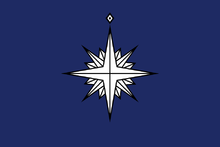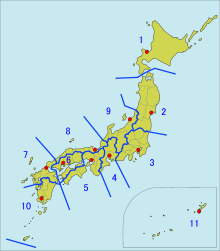- Japan Coast Guard
-
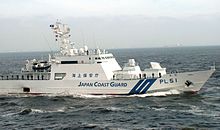 A vessel of the Japan Coast Guard – Hida powered with four MTU 20V1163TB93 diesel engines
A vessel of the Japan Coast Guard – Hida powered with four MTU 20V1163TB93 diesel engines
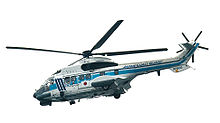 A Eurocopter AS322 Super Puma of the Japanese coast guard flying over Tokyo Bay
A Eurocopter AS322 Super Puma of the Japanese coast guard flying over Tokyo Bay
The Japan Coast Guard (海上保安庁 Kaijō Hoan-chō), formerly the Maritime Safety Agency, is the Japanese coast guard. Comprising about 12,000 personnel, it is under the oversight of the Ministry of Land, Infrastructure, Transport and Tourism, and is responsible for the protection the coast-lines of Japan. It was founded in 1948.
Contents
Overview
The duty of the JCG is to ensure security and safety at sea.This provided through the following services:
- Maritime patrol – patrols Japan's territorial seas and Exclusive Economic Zone (EEZ) of (12–200 nautical miles out from the shore which is approximately 4,470,000 km2.[1]
- Countermeasures against Smuggling and Illegal Immigration
- Countermeasures against Piracy (Regional Cooperation Agreement on Combating Piracy and Armed Robbery against Ships in Asia-ReCAAP)
- Counter Terrorism
- Security against Maritime Conflict – includes the Special Guard Team
- Surveillance of Illegal Operations by Foreign Fishing Vessels
- Countermeasures against Suspicious Vessels and/or Spy Ships
- Dealing with Unlawful Acts by Foreign Oceanographic Research Vessels
- Patrolling and Guarding the Waters near the Senkaku Islands, Takeshima, and the Northern Territories
- Search and rescue
- Hydrographic and oceanographic surveying
- Maritime traffic management
Organization
National Headquarters
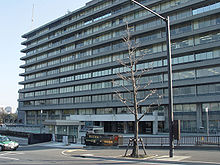 Main building of the Ministry of Land, Infrastructure, Transport and Tourism in Kasumigaseki, under which the Japan Coast Guard operates, and where it is headquartered
Main building of the Ministry of Land, Infrastructure, Transport and Tourism in Kasumigaseki, under which the Japan Coast Guard operates, and where it is headquartered
The Japan Coast Guard is led by Commandant Hiroyasu Suzuki and two Vice Commandants. Lower ranking officers include the director general, directors and inspector generals.
Organization (as of April 1, 2009)
- Commandant
- Vice Commandant
- Vice Commandant for Operations
- Administrative Inspector General
- Administration Department
- Coast Guard Research Center
- Equipment and Technology Department
- Guard and Rescue Department
- Hydrographic and Oceanographic Department
- Maritime Traffic Department
- Coast Guard Academy (Kure)
- Coast Guard School (Maizuru)
- Moji Branch school (Kitakyushu)
- Miyagi Branch school(Iwanuma)
The Japan Coast Guard Academy is a 4-year-training institution, located in Kure, Hiroshima prefecture, established within the Coast Guard for the purpose of training students to become officers. Graduates are given a bachelor's degree upon graduation. About 40 cadets graduate from the academy each year.
The JCG maintains two special forces units:
- the Special Security Team (SST) (特殊警備隊 Tokushu Keibi Tai) and
- the Special Rescue Team (SRT) (特殊救難隊 Tokushu Kyūnan Tai).
History
Founded in 1948 as the Maritime Safety Agency of Japan, its English name was changed to Japan Coast Guard in April 2000.[2] In 1950, the Maritime Safety Agency sent minesweepers to the Korean Peninsula under the United Nations flag during the Korea War.
On December 22, 2001, JCG ships intercepted a Chinese-flagged vessel believed to be North Korean in origin, in the Japanese Exclusive Economic Zone between Kyushu and China. When the vessel failed to respond, she was fired upon by the JCG and an exchange of gunfire resulted. The unidentified vessel sank in the Chinese EEZ with all hands.[3] The ship, later salvaged by the JCG, was found to be carrying weapons and spy equipment.[4] The wreck and its contents were put on display at the Japanese Coast Guard Museum at Yokohama.[5]
Operational regions
Headquartered in Tokyo, the JCG has divided the nation into eleven regions to facilitate its coast guard operations. Each region maintains a Regional Coast Guard Headquarters, under which there are various Coast Guard Offices, Coast Guard Stations, Air Stations, Hydrographic Observatory, and Traffic Advisory Service Centers.
- 1st Regional Coast Guard Headquarters: Otaru, Hokkaidō (including southern Kuril islands)
- 2nd Regional Coast Guard Headquarters: Shiogama, Miyagi
- 3rd Regional Coast Guard Headquarters: Yokohama
- 4th Regional Coast Guard Headquarters: Nagoya
- 5th Regional Coast Guard Headquarters: Kobe
- 6th Regional Coast Guard Headquarters: Hiroshima
- 7th Regional Coast Guard Headquarters: Kitakyūshū
- 8th Regional Coast Guard Headquarters: Maizuru, Kyoto
- 9th Regional Coast Guard Headquarters: Niigata, Niigata
- 10th Regional Coast Guard Headquarters: Kagoshima
- 11th Regional Coast Guard Headquarters: Naha, Okinawa (including Senkaku Islands)
Major equipment
Vessels
Main article: List of Japan Coast Guard vessels and aircraftThe JCG operates 455 watercraft, these include the following:
- Patrol Vessels: 121
- Patrol craft: 234
- Special guard and rescue craft: 63
- Hydrographic survey vessels: 13
- Aids to navigation evaluation vessels: 1
- Buoy tenders: 2
- Aids to navigation tenders: 18
- Training boats: 3
Aircraft
The JCG operates 73 aircraft, these include:
- Fixed Wing 27
- Helicopters 46
See also
- Japan Coast Guard Academy
- Japan Coast Guard Museum
- Umizaru
- Umizaru 2: Test of Trust
- Battle of Amami-Ōshima
References
- ^ http://www.kaiho.mlit.go.jp/e/pamphlet.pdf
- ^ New Fighting Power! Retrieved on April 25, 2008.
- ^ 国境を守る海上保安庁. (Japanese)
- ^ 北朝鮮 工作船. (Japanese)
- ^ 海上保安資料館 横浜館-Japan Coast Guard Museum YOKOHAMA-. (Japanese)
External links
- Official Site (Japanese)
- Official site (English)
- JCG Academy Official Site (Japanese)
- Details of vessels on Thomasphoto (Japanese)
- Details of vessels on VSPG (Japanese)
Coast guards Argentina · Aruba · Australia · Bangladesh · Barbados · Belize · Canada · China · Croatia · Cyprus · Egypt · France · Germany · Greece · Haiti · Iceland · India · Ireland · Italy · Japan · South Korea · Malaysia · Maldives · New Zealand · Netherlands · Netherlands (Caribbean) · Norway · Pakistan · Peru · Philippines · Russia · Singapore · Sri Lanka · Sweden · Taiwan · Turkey · Ukraine · United Arab Emirates · United Kingdom · United States of America · VietnamCategories:- Japan Coast Guard
- Coast guards
- Maritime patrol – patrols Japan's territorial seas and Exclusive Economic Zone (EEZ) of (12–200 nautical miles out from the shore which is approximately 4,470,000 km2.[1]
Wikimedia Foundation. 2010.

